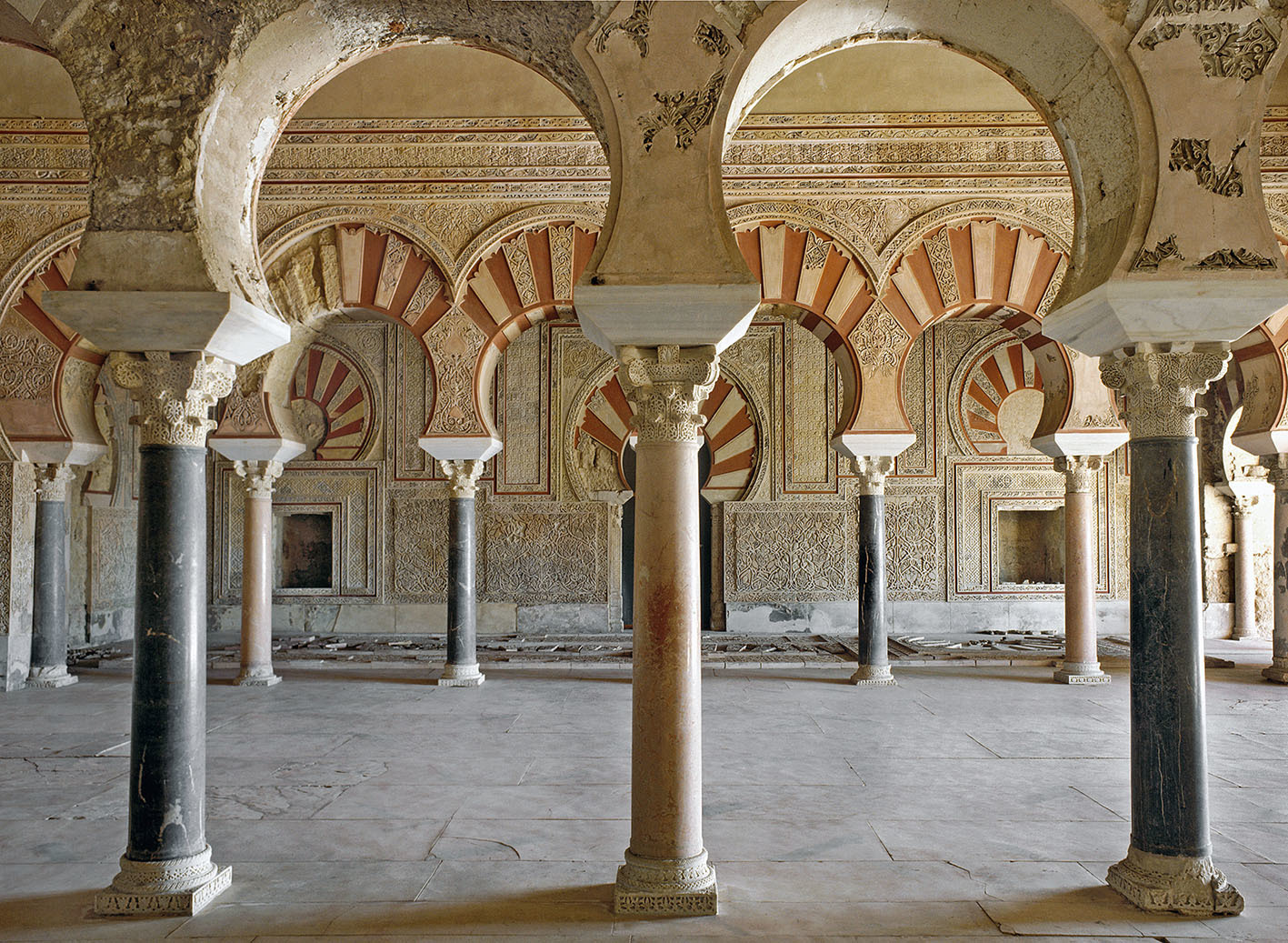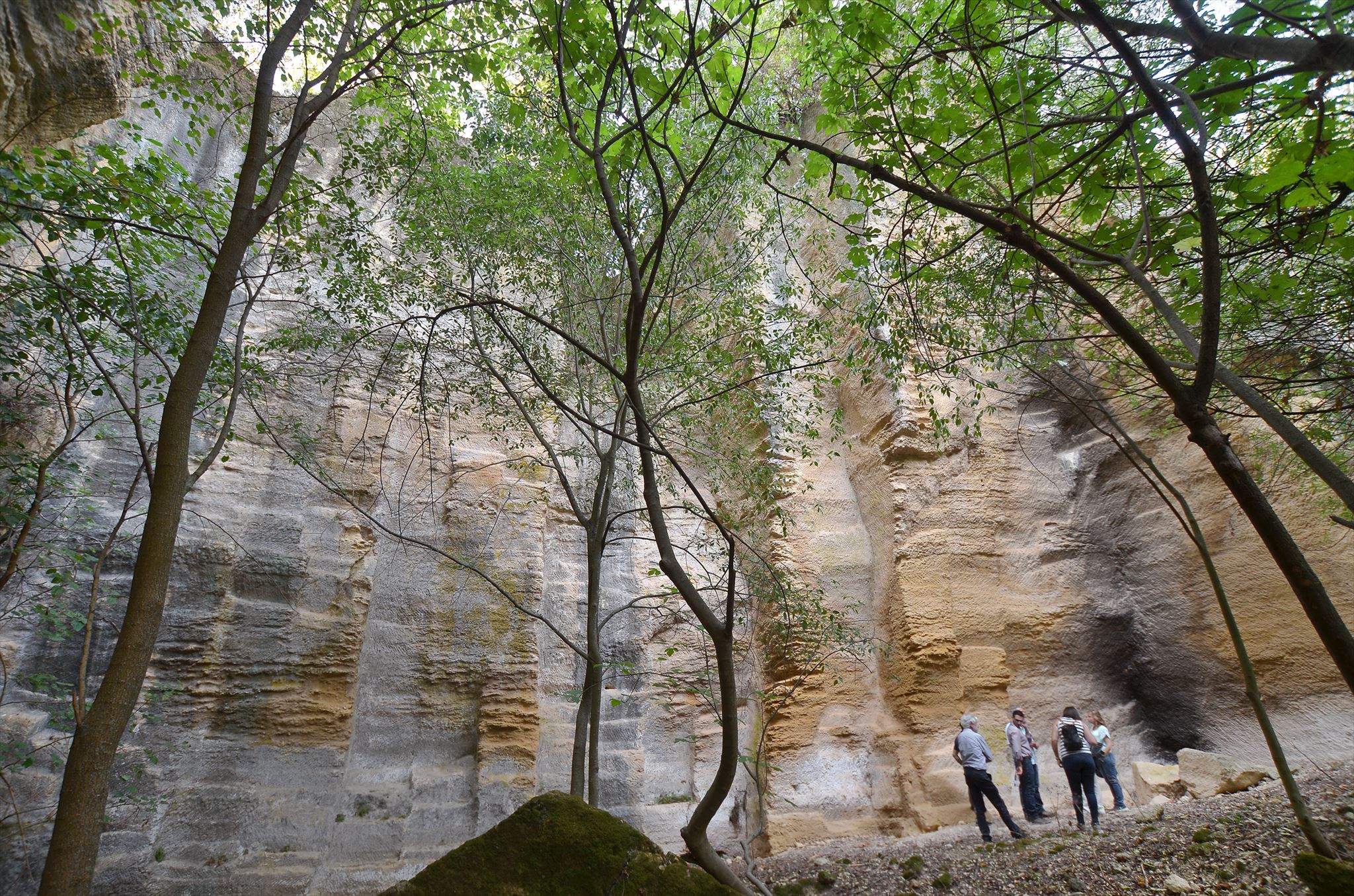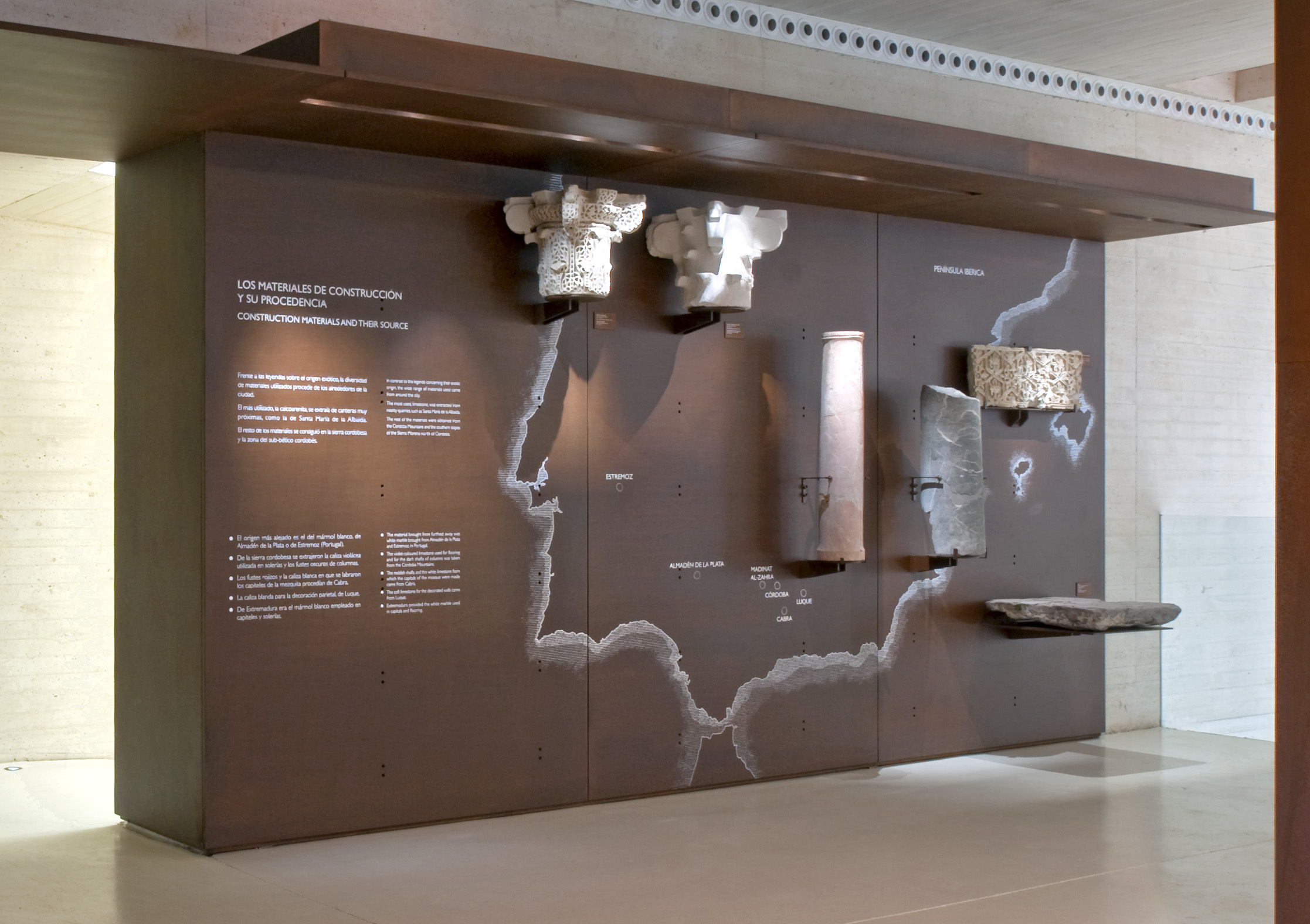
LA PIEDRA COMO MATERIAL CONSTRUCTIVO EN EL SIGLO X
Con la implantación del primer Estado islámico en al-Andalus, en el último cuarto del siglo VIII, reaparecieron la cantería de sillares y la producción de ladrillos cocidos a gran escala, lo que supuso, junto con la aparición de un nuevo tipo de tejas, una innovación de gran calado en el ámbito constructivo. A partir de este momento, el empleo de la sillería se convirtió en una de las señas de identidad del Estado emiral, aunque no alcanzó su pleno desarrollo hasta el siglo X con la proclamación del califato y su extraordinario programa constructivo.
Todo el programa arquitectónico del Estado califal en Córdoba se ejecutó con este sistema constructivo, no sólo la Mezquita Aljama y Medina Azahara sino también las infraestructuras públicas de puentes y acueductos, las almunias edificadas por las altas personalidades, etc.
Pero los requerimientos pétreos más importantes fueron, sin duda, los exigidos por la construcción de Medina Azahara que se convirtió en el mayor proyecto urbanístico del Islam en al-Andalus. Su fundación obedeció a una práctica oriental iniciada en el califato abbasí que vincula la dignidad califal con la construcción de un nuevo centro urbano próximo a la ciudad preexistente, con la que no establecía una relación de competencia sino de complementariedad en sus distintas funciones urbanas.
Toda la muralla que delimitaba su perímetro, así como la que separaba el Alcázar de la Medina propiamente dicha, fue levantada con sillares de piedra desde su cimentación. Igualmente, la totalidad de las estructuras levantadas dentro del Alcázar se erigieron, desde su arranque, con sillares dispuestos a soga y tizón. Ante la magnitud del programa constructivo cabe preguntarse de dónde salió esta ingente masa de piedra.
 Frente de cantera en Santa María de la Albaida
Frente de cantera en Santa María de la Albaida
LAS CANTERAS Y EL SISTEMA DE EXTRACCIÓN
El material básico empleado es una piedra calcarenita de origen sedimentario marino, caracterizada por la abundante presencia de fósiles. Procede de un afloramiento de materiales terciarios del Mioceno, que se encuentran en la zona de contacto entre el cuaternario del valle del Guadalquivir y el frente paleozoico de la sierra. La facilidad para su trabajo, la cercanía a las obras a realizar y la buena relación peso-volumen que caracteriza a este tipo de piedra hicieron que se empleara como el material constructivo básico en Córdoba desde época romana.
Las huellas de esta actividad extractiva histórica se evidencian en distintos lugares por tratarse en general de una actividad dispersa en multiplicidad de explotaciones de pequeño y mediano tamaño. El conjunto extractivo más completo e interesante desde todos los puntos de vista se sitúa en torno al llamado Cortijo de Santa Ana de la Albaida, un conjunto de explotaciones de diferente tamaño y morfología que constituye un documento precioso sobre los procedimientos extractivos y la organización del trabajo de la época.
En Santa Ana de la Albaida conviven dos tipos de canteras, una de pequeño tamaño y forma ligeramente circular, que se caracteriza por un corredor de no más de 4 m de ancho de forma rectangular que conduce a un espacio de explotación irregular a cielo abierto donde se conservan fosilizadas las cajas de extracción de sillares, y otro de frentes amplios más o menos lineales.
Los alzados muestran una altura de suelo a techo que alcanza, en los casos más altos, los 20 m a partir del nivel actual de colmatación. Los estratos se disponen ligeramente horizontales, observándose las distintas calidades de los mismos que van desde frentes compactos de roca bien cementada, hasta otros arenosos caracterizados por la abundante presencia de fósiles. Esta misma diversidad se observa también en los sillares de Medina Azahara donde conviven piezas de diferente calidad en una misma estructura, lo que implica que no hubo un proceso selectivo riguroso de las vetas pues los frentes se aprovecharon de manera exhaustiva. Probablemente, esta circunstancia tenga que ver con el hecho de que todas las estructuras constructivas fueron finalmente recubiertas con un enlucido de cal y arena, hoy prácticamente perdido, que les garantizó su protección.
Además de la piedra base para la construcción de tipo estructural obtenida de las canteras cercanas, a Medina Azahara llegaron piedras no disponibles en el entorno cercano y cuya utilidad era cumplir otras funciones constructivas específicas: caliza blanca para capiteles, caliza violácea para solería, mármol para zonas nobles…
Texto extraido de "http://www.academia.edu/3756929/Las_canteras_de_Madinat_al-Zahra"
Para poder registrar este earthcaché tendrás que mandar un email al propietario respondiendo al menos a 3 de las siguientes preguntas
1.- Cual es el material básico de las piedras que se extraen de estas canteras cercanas a la ciudad y cuál es su origen.
2.- De qué dos pueblos cordobeses procede la caliza blanca que se utiliza en los capiteles de la mezquita y la caliza blanda de la decoración parietal.
3.- Que altura máxima se puede observar actualmente en las canteras de la Albaida.
4.- Cual es el lugar de origen del material más alejado -mármol blanco- que llega a Medina Azahara.
Resolución: Dos de las preguntas están directamente respondidas en el texto que se acompaña. Las otras dos se pueden responder con los datos del panel explicativo (que puedes ver en la fotografía de abajo) dedicado a Materiales Constructivos que se encuentra en el Museo del Centro de Interpretación de Medina Azahara. Abierto todos los días del año excepto los lunes y alguna fiesta señalada.
Consultar horarios de apertura: http://www.medinaazahara.org/horarios-medina-azahara.html

-English-
THE STONE AS A CONSTRUCTIVE MATERIAL IN THE 10th CENTURY
With the implantation of the first Islamic State in al-Andalus, in the last quarter of the 8th century, the stonework of ashlars and the production of large-scale fired bricks reappeared, which meant, together with the appearance of a new type of tiles, an innovation of great importance in the productive field and in the specialization of work processes. From this moment, the use of the ashlar masonry became one of the hallmarks of the emiral state, although it did not reach its full development until the tenth century with the proclamation of the caliphate and its extraordinary constructive program.
The entire architectural program of the Caliphate State in Córdoba was executed with this construction system, not only the Aljama Mosque and Medina Azahara but also the public infrastructure of bridges and aqueducts, las almunias built by high personalities, etc.
But the most important stone requirements were, without a doubt, those demanded by the construction of Medina Azahara, which became the largest urban project of Islam in al-Andalus. Its foundation was due to an oriental practice initiated in the Abbasid caliphate that links the Caliphate dignity with the construction of a new urban center near the pre-existing city, with which it did not establish a relationship of competition but of complementarity in its different urban functions.
The entire wall that delimited its perimeter, as well as the one that separated the Alcazar from the Medina proper, was raised with stone ashlars from its foundation. Likewise, the totality of the structures erected within the Alcázar were erected, from its start, with ashlars arranged to rope and blight. Given the magnitude of the constructive program, it is necessary to ask where this huge mass of stone came from.
THE QUARRIES AND THE EXTRACTION SYSTEM
The basic material used is a Calcarenite stone of marine sedimentary origin, characterized by the abundant presence of fossils. It comes from an outcrop of Miocene tertiary materials, which are located in the contact area between the Quaternary of the Guadalquivir Valley and the Paleozoic front of the sierra. The ease of work, the proximity to the works to be performed and the good weight-volume relationship that characterizes this type of stone made it used as the basic building material in Cordoba since Roman times.
The traces of this historical extractive activity are evidenced in different places because it is generally a dispersed activity in multiplicity of small and medium size farms. The most complete and interesting extractive set from all points of view is located around the so-called Cortijo de Santa Ana de la Albaida, north of Turruñuelos, where a set of farms of different sizes are recognized and morphology that constitutes a precious document on the extractive procedures and the organization of the work of the time.
Two types of quarries coexist in Santa Ana de la Albaida, one of small size and slightly circular shape, characterized by a corridor that is no more than 4 m wide and rectangular in shape, leading to an irregular open-air exploitation space where the boxes of extraction of ashlars are preserved, and another one of broad fronts more or less linear.
The elevations show a height from floor to ceiling that reaches, in the highest cases, 20 m from the current level of clogging. The strata are arranged slightly horizontal, observing the different qualities of the same that go from compact fronts of well cemented rock, to other sandy ones characterized by the abundant presence of fossils. This same diversity is also observed in the Medina Azahara ashlars where pieces of different quality coexist in the same structure, which implies that there was not a rigorous selective process of the veins since the fronts were used exhaustively. Probably, this circumstance has to do with the fact that all the construction structures were finally covered with a lime and sand plaster that guaranteed their protection.
In addition to the base stone for the structural type construction obtained from the nearby quarries, Medina Azahara arrived stones not available in the surrounding area and whose utility was to fulfill other specific construction functions: white limestone for capitals, violet limestone for flooring, marble for noble areas ...
Text extracted from "http://www.academia.edu/3756929/Las_canteras_de_Madinat_al-Zahra"
In order to register this earthcache you will have to send an email to the owner answering at least 3 of the following questions
1.- What is the basic material of the stones that are extracted from these quarries near the city and what is their origin?
2.- From which two villages of Cordoba comes the white limestone that is used in the capitals of the mosque and the soft limestone of the parietal decoration?
3.- What maximum height can currently be observed in the Albaida quarries?
4.- What is the place of origin of the furthest material - white marble - that reaches Medina Azahara?
Resolution: Two of the questions are directly answered in the text above. The other two can be answered with the data of the explanatory panel (what can you see in the picture below) dedicated to Constructive Materials that is in the Museum of the Interpretation Center of Medina Azahara. Open every day of the year except Mondays and some indicated holidays.
Check opening days and times at: http://www.medinaazahara.org/horarios-medina-azahara.html
